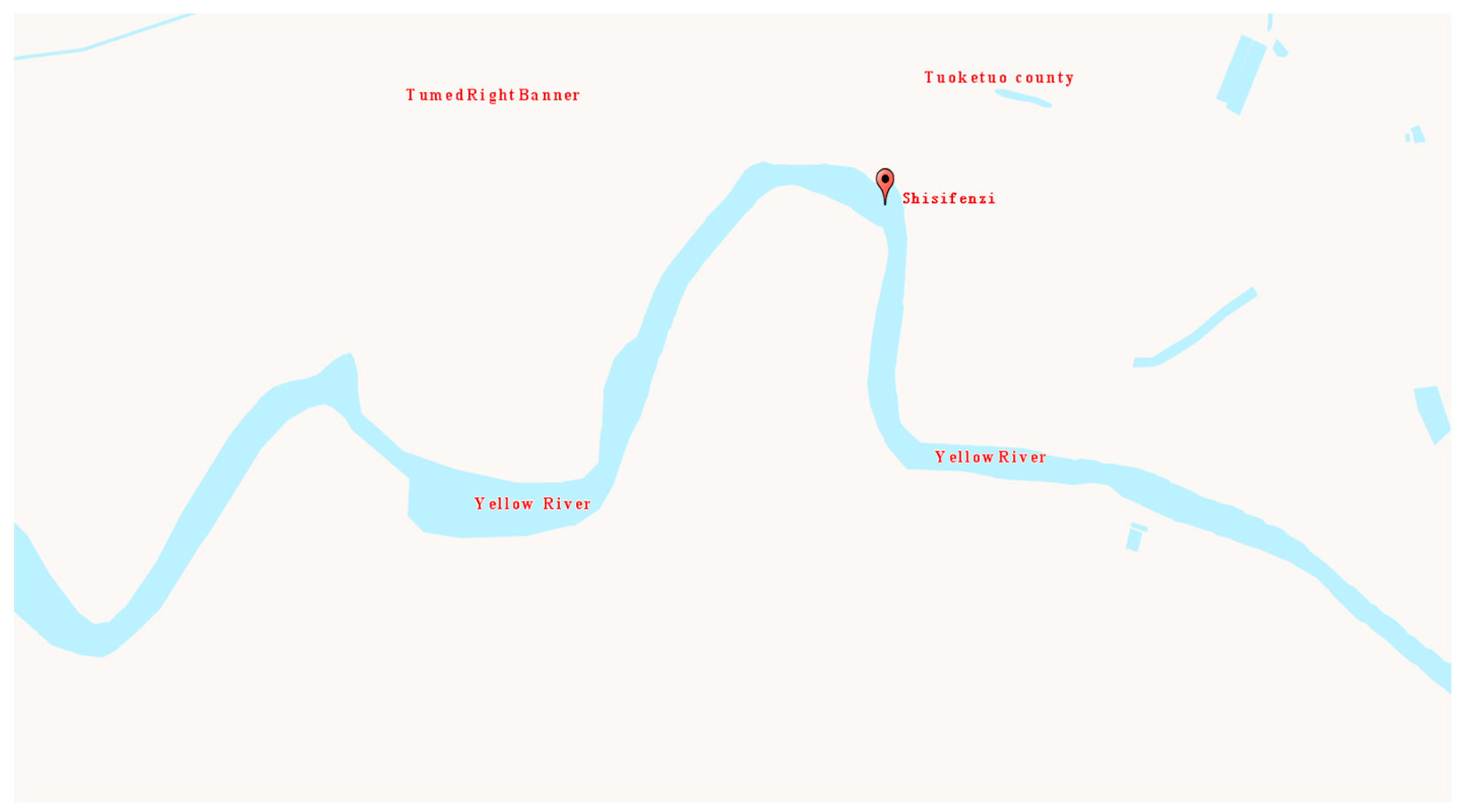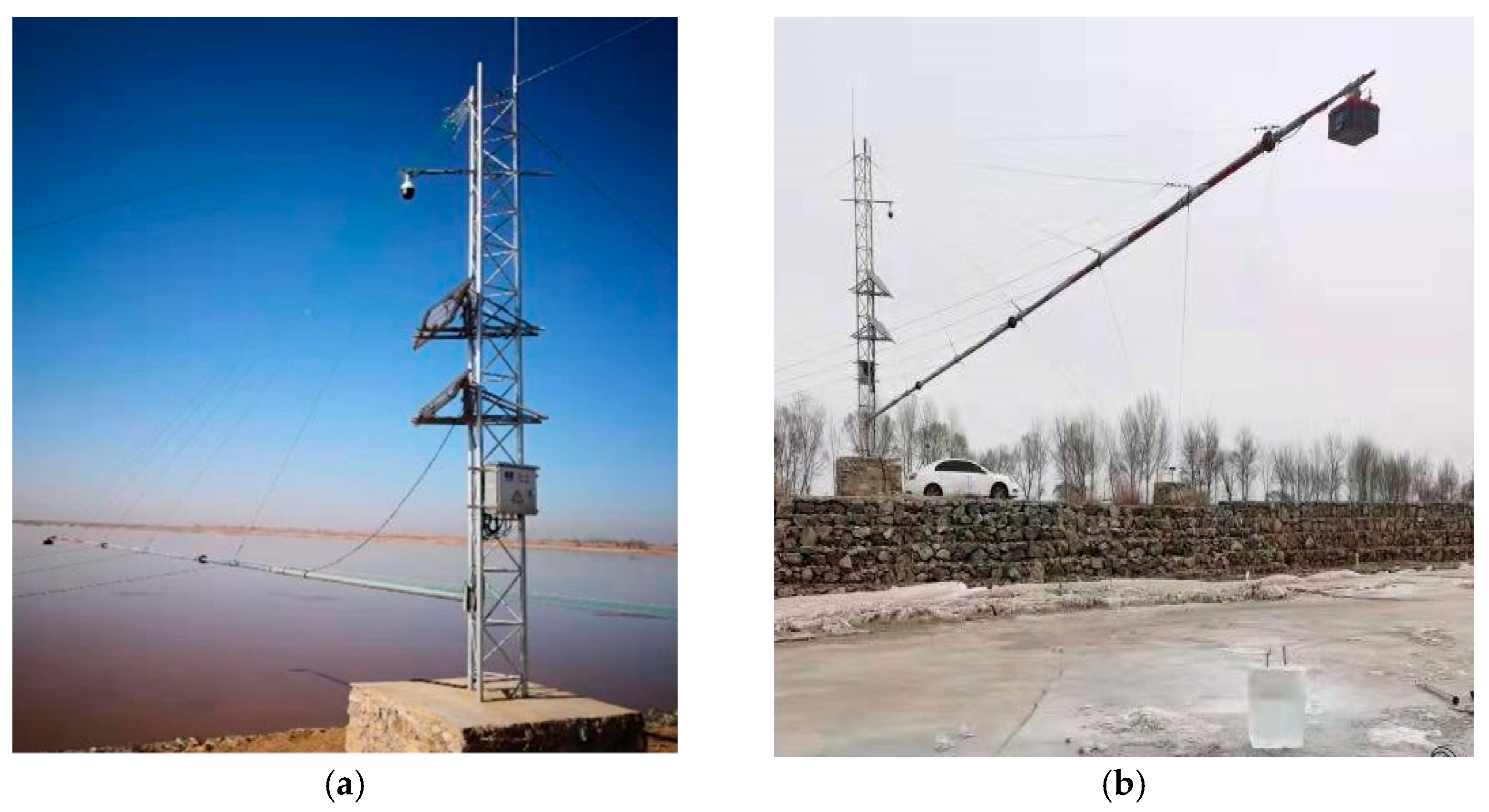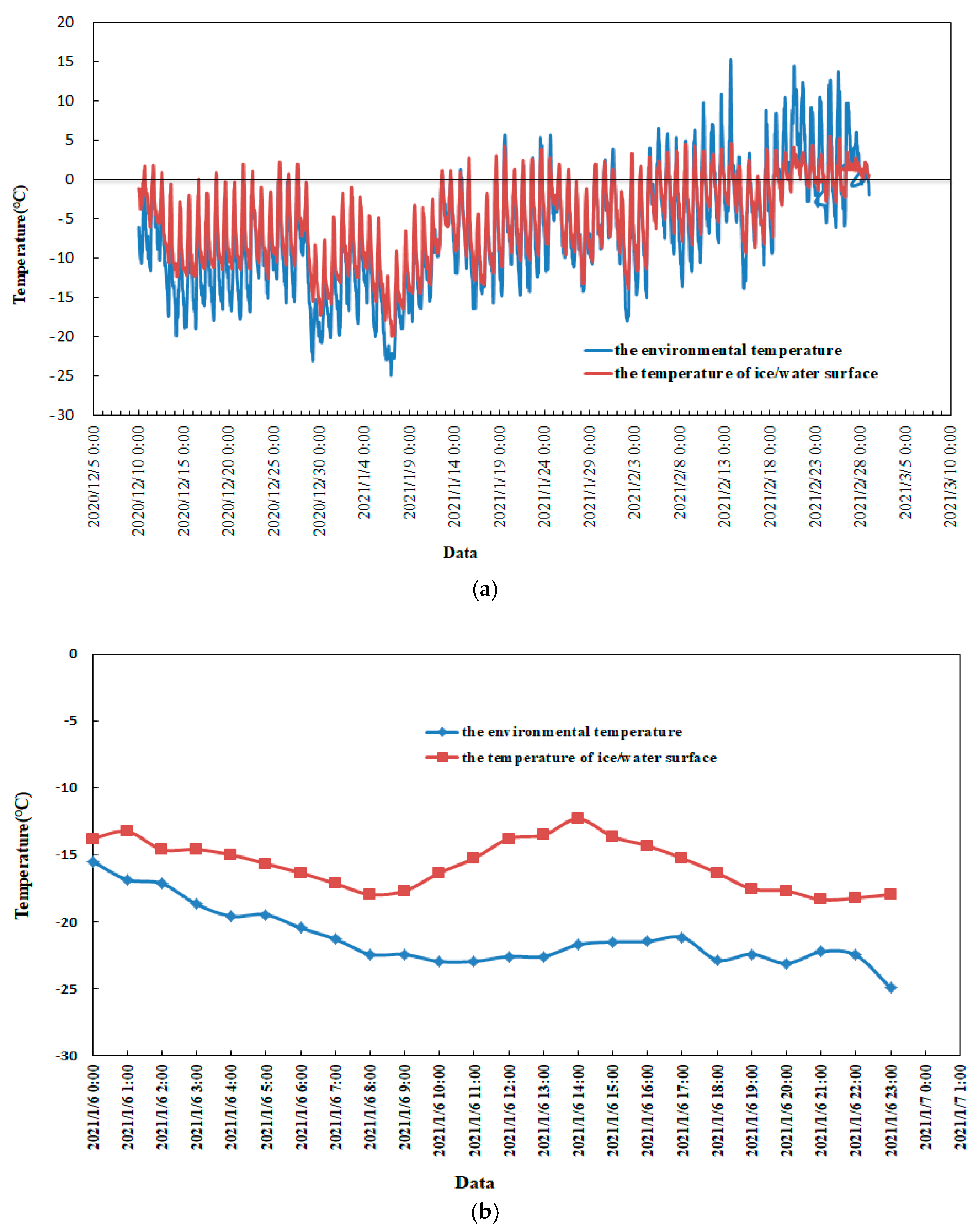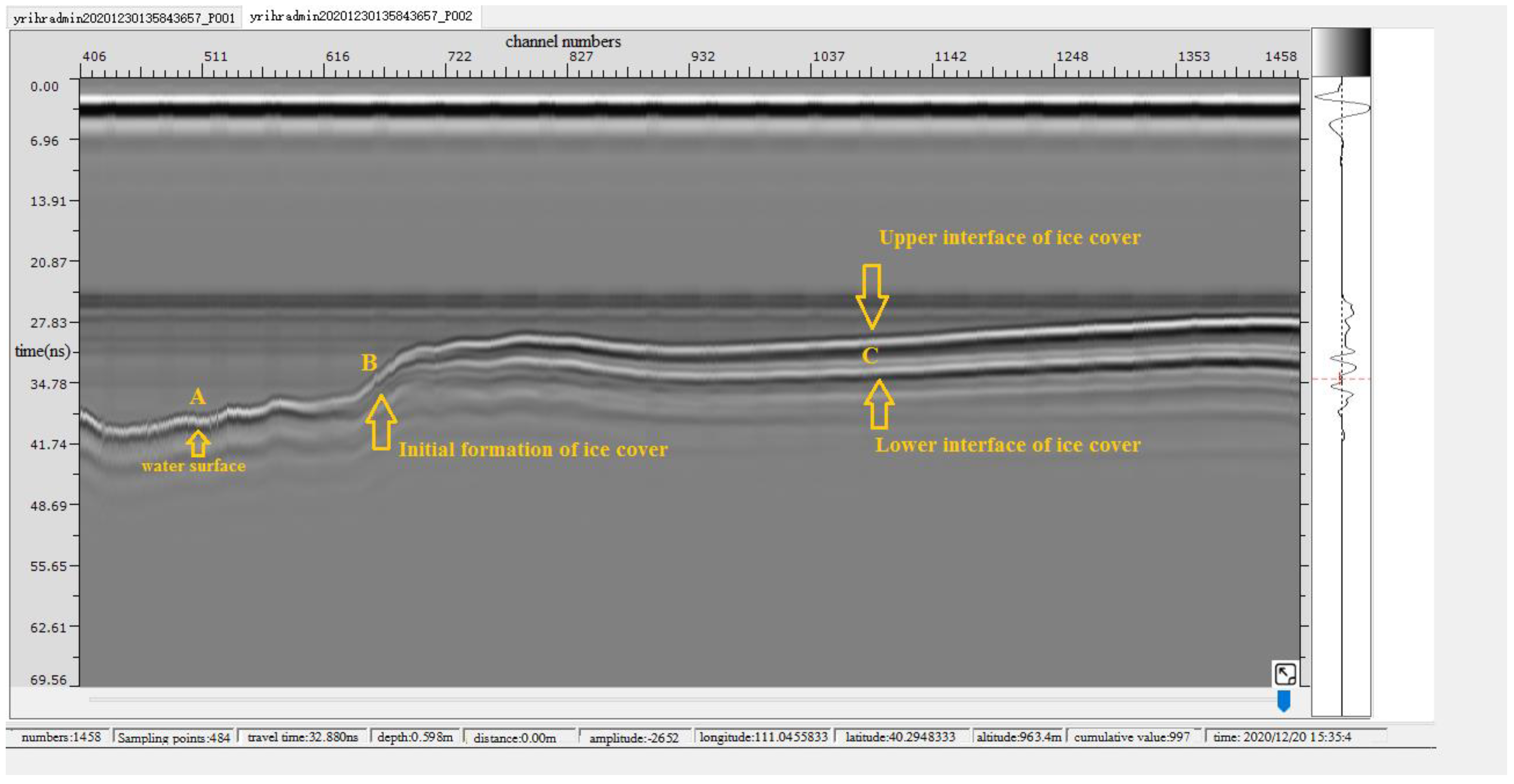Dynamic and Full-Time Acquisition Technology and Method of Ice Data of Yellow River
Abstract
:1. Introduction
- (1)
- There are few field observation sections in the field and few characteristic sections in particular. At present, the ice factor observation data of the Inner Mongolia section of the Yellow River mainly come from the BayanGaole hydrological station, Sanhuhekou hydrological station, Baotou hydrological station, and Toudaoguai hydrological station. This arrangement is still insufficient to fully understand the formation and development of ice jams, ice dams, and ice disasters of the Yellow River, especially at the bend of the river and the river section prone to ice disasters year round.
- (2)
- There are few field observations, and the real-time performance is poor. The existing field observation data are sporadically distributed, some involve only the freeze ice and ice breakup period of a year, and some are in the no-ice period. This makes it difficult to study the ice change law and the ice growth and dissipation change of the Yellow River. In the meantime, the accuracy of the relevant mathematical prediction models is also not high. Therefore, it is necessary to establish a long-term continuous field observation system to obtain the field data of all ice periods of the Yellow River, such as the no-ice period, flow ice period, freeze ice period, and breakup ice period.
- (3)
- The field observation data are not comprehensive. At present, the field data of the ice period of the Yellow River mainly include conventional hydrometeorological data, such as temperature, water temperature, water level, ice thickness, etc. The formation and scale of ice dams and ice jams in ice periods are not only determined by conventional hydrometeorological data, but also related to ice thickness, ice transport velocity, and river section conditions. Other factors should also be considered, such as the amount of sediment transport under ice sheets, the amount of river terrain change, and the amount of channel erosion and deposition. Additional factors, such as air pressure, radiation, sediment concentration, and ice density, should be considered in the mathematical models for predicting the freeze-up time and breakup time. Therefore, it is necessary to observe more influencing factors related to ice in the field and establish a thematic database of ice elements and river terrain databases in the future to provide big data support for the accurate analysis of ice in the Yellow River in the future.
- (4)
- The field observation equipment and technology are not modern, the degree of automation is low, the field test cycle is long, and the labor intensity is high. Field observation equipment and technology are mostly based on artificial methods, which are inefficient and dangerous, especially in periods of ice jams and ice dams. The technology for monitoring frazil ice formation and migration is still lacking. The ice mechanics parameters need to be obtained by indoor experiments.
2. Tests and Methods
2.1. System Hardware Composition
2.2. Installation of Equipment
2.3. Experimental Algorithm
- (1)
- Homogeneity
- (2)
- Similarity
3. Results
3.1. Temperature Changes
3.2. Flow Ice Velocity and Density
3.3. Ice Thickness and Water Level
4. Discussion
4.1. Verification Analysis of Ice Thickness
4.2. Advantages of the Monitoring Device
4.3. Adverse and Supplementary Measures for the Monitoring Device
5. Conclusions
- (1)
- Monitoring technology is a fixed-point, noncontact, and multiparameter ice monitoring technology that can not only synchronously observe the changes in water level and ice thickness, but also observe the ice, water surface temperature, and air temperature, as well as automatically take photos and videos at fixed angles at fixed times and over the whole ice period. The equipment has endured adverse weather conditions, such as blizzards, heavy fog, continuously cloudy days, strong winds above level 10, and a minimum temperature of −31 °C.
- (2)
- The temperature change process in the 2020–2021 ice period was continuously monitored. The minimum environmental temperature was −24.93 °C at 23:00 on 6 January, and the minimum ice temperature was −19.97 °C at 1:00 on 7 January in the 2020–2021 ice period.
- (3)
- The first flow ice of the 2020–2021 ice period in the Shisifenzi reach of the Yellow River appeared on 24 November 2020. The maximum flow ice velocity was 1.33 m/s, which is in the mainstream velocity region. The average flow ice velocity was 0.5–1 m/s. The flow ice velocity was relatively stable during the whole flow ice period of 2020–2021.
- (4)
- The maximum flow ice density occurred on 6 December, which was 85.82%, and then the flow ice density gradually decreased. On 6 December, the river section was frozen and blocked as a whole.
- (5)
- The first ice thickness data were accurately captured on 11 December 2021. The maximum ice thickness reached 52 cm. On 26 February 2021, the ice cover broke up, floating ice drifted downstream, the ice thickness data disappeared, and the water level decreased significantly, indicating that the river section opened up. From 3 to 8 March 2021, ice thickness was still measured at the Shisifenzi section, which was mainly caused by floating ice accumulation from upstream.
- (6)
- Two methods can be adopted to improve the ice monitoring of the Yellow River: One is to add more representative monitoring points, and the other is the combination of local observations and macropatrol surveys.
Author Contributions
Funding
Institutional Review Board Statement
Informed Consent Statement
Acknowledgments
Conflicts of Interest
References
- Zanting, C. Development of ice observation and research on the Yellow River. Sci. Technol. Inf. Yellow River 1989, 1, 15. [Google Scholar]
- Jueyi, S. Riverbed evolution during freezing period in Longkou-Tianqiao section of the middle reaches of the Yellow River. Acta Geogr. Sin. 1992, 5, 209–219. [Google Scholar]
- Jueyi, S.; Daxian, F.; Yafei, Z. Analysis and calculation of the ice jam stage in the Hequ Reach of the Yellow River. Hydrology 1994, 2, 18–24. [Google Scholar]
- Zanting, C. Study on ice conditions of rivers, lakes and seas in China. J. Glaciol. Geocryol. 1988, 3, 279–283. [Google Scholar]
- Sun, Z.; Sui, J. Research on river ice jam and its significance. Adv. Earth Sci. 1990, 3, 51–54. [Google Scholar]
- Jueyi, S.; Xianda, F.; Yafei, Z. Critical conditions of ice diving in front of ice cover. J. Hydraul. Eng. 1993, 10, 46–51. [Google Scholar]
- Sujuan, K.; Min, W.; Suqiu, R. Study on the Ice of the Yellow River; Yellow River Water Conservancy Press: Zhengzhou, China, 2002. [Google Scholar]
- Jun, W. A laboratory study of starting velocity of no cohesive sediment under ice cover. Hydro-Sci. Eng. 1998, 2, 164–169. [Google Scholar]
- Jun, W. A study on ice jam in balance transporting discharge. J. Hydroelectr. Eng. 2002, 1, 61–67. [Google Scholar]
- Jun, W. A study on the relations about balance ice jam thickness with its flow conditions and ice discharge. J. Lanzhou Univ. Nat. Sci. 2002, 38, 117–121. [Google Scholar]
- Jun, W.; Hui, F.; Mingkun, Y.; Yunji, Y.; Yuexia, G. Analysis of stages under-covered in winter. Adv. Water Sci. 2007, 18, 102–107. [Google Scholar]
- Parkinson, F.E. Water temperature observations during breakup on the Liard-Mackenzie River system. In Proceedings of the Workshop on Hydraulics of Ice-Covered Rivers, Edmonton, AB, Canada, 1–2 June 1982; pp. 261–295. [Google Scholar]
- Marsh, P.; Prowse, T.D. Water temperature and heat flux at the base of river ice covers. Cold Reg. Sci. Technol. 1987, 14, 33–50. [Google Scholar] [CrossRef]
- Gerard, R.; Jasek, M. Break-Up Observations and Ice Jam Flood Forecast Algorithm Evaluation, Hay River, NWT, 1989; Department of Civil Engineering, University of Alberta: Edmonton, AB, Canada, 1990; pp. 90–93. [Google Scholar]
- Ford, J.S.; Beltaos, S.; Moody, W.J.; Madsen, N. Remote measurement of ice jam thickness. In Proceedings of the 6th Workshop on Hydraulics of Ice Covered Rivers, Edmonton, AB, Canada, 18–20 June 1991; pp. 270–296. [Google Scholar]
- Brian, M.; Masoud, H.; Bourel, C. Characteristics of ice in the St. Lawrence River. Can. J. Civ. Eng. 2003, 30, 766–774. [Google Scholar]
- Jasek, M.; Hydro, B.; Marko, J.R.; Fissel, D.B. Instrument for detecting freeze-up, mid-winter and break-up ice processes in rivers. In Proceedings of the 13th Workshop on the Hydraulics of Ice Covered Rivers, Edmonton, AB, Canada, 15–16 September 2005; pp. 150–183. [Google Scholar]
- Desheng, M.; Zhenbao, W.; Tao, M. A introduction to the ice thickness monitoring of pile type without freezing hole. Hydrology 2001, 21, 61–62. [Google Scholar]
- Baosen, Z.; Guoming, G. Experimental study on the monitoring technology of ice flow on Ningxia-Inner Mongolia section of the Yellow River. J. Heilongjiang Hydraul. Eng. 2009, 4, 90–95. [Google Scholar]
- Li, Z. An introduction of the techniques for sea ice investigation during the 19th Chinese Antarctic expedition. J. Glaciol. Geocryol. 2003, 25, 210–213. [Google Scholar]
- Zhijun, L.; Zhanhai, Z.; Xilu, D.; Peng, L. A new observation technology of key indexes of Arctic sea ice generation and dissipation. Prog. Nat. Sci. 2004, 14, 1077–1080. [Google Scholar]
- Zhijun, L.; Zhanhai, Z. Sea ice investigation in China 2003 and future arctic ice research tactic. Chin. J. Polar Res. 2004, 16, 202–210. [Google Scholar]
- Yihua, C. The method for measuring ice interface using non-linear acoustics. Ocean Technol. 2005, 24, 58–60. [Google Scholar]
- Jianmin, Q.; Bing, S. New ice thickness sensor based on electric conduction characteristic of water and ice. J. Transducer Technol. 2004, 23, 55–56. [Google Scholar]
- Jianmin, Q. Research on Theory and Application for Detecting the Thickness of Ice Layer Based on Distinct Conductivity of Air, Ice and Water. Ph.D. Thesis, Xi’an University of Technology, Xian, China, 2005. [Google Scholar]
- Jianmin, Q.; Peng, C.; Mingqi, Q. Ice layer-thickness sensor and its measuring method. Adv. Water Sci. 2008, 3, 418–421. [Google Scholar]
- Peitong, C.; Ruilan, W.; Cuixia, L. Ground resistivity technique measurement for ice jam early warning at freeze-up period of the Yellow River. Adv. Water Sci. 2006, 17, 877–880. [Google Scholar]
- Peitong, C.; Zhenxing, M.; Xiangjun, L. Preliminary study on geo-electricity early warning of Yellow River ice slush. J. Tianjin Norm. Univ. Nat. Sci. Ed. 2007, 27, 43–45. [Google Scholar]
- Junjie, Y.; Liangming, L.; Haolu, M. Application for MODIS data on the ice flood monitoring of Yellow River. Geomat. Inf. Sci. Wuhan Univ. 2004, 29, 679–681. [Google Scholar]
- Zhihui, X.; Liangming, L. Dynamic and real-time monitoring on ice-jam flood of Ningxia-Inner Mongolia reach of Yellow River based on MODIS data. Water Resour. Hydropower Eng. 2007, 9, 58–61. [Google Scholar]
- Yu, D.; Sue, Y. The application of UAV remote sensing system on ice monitoring for Yellow River. China Flood Drought Manag. 2016, 4, 34–38. [Google Scholar]
- Hui, L.; Honglan, J.; Xianyou, M.; Guoming, G.; Baosen, Z. Experimental study on Yellow River ice thickness monitoring test based on UAV Radar technology. South-North Water Transf. Water Sci. Technol. 2020, 3, 217–224. [Google Scholar]
- Hui, L.; Honglan, J.; Hongchun, L.; Guoming, G.; Baosen, Z. Application of UAV radar in survey of ice thickness and ice structure. J. Drain. Irrig. Mach. Eng. 2021, 6, 630–636. [Google Scholar]














| Parameters | Values |
|---|---|
| radar center frequency | 400 MHz |
| sampling points | 256/512/1024/2048 |
| sampling frequency | 50 GHz/25 GHz/10 GHz/5 GHz |
| maximum detection time window | 400 ns |
| stacking numbers | 1~128 |
| maximum detection thickness | 5 m |
| maximum height of radar from water surface | 20 m |
| power supply mode | hybrid wind/PV power |
| power consumption | 10 W |
| working temperature | −40~+50 °C |
| storage temperature | −45~+85 °C |
Publisher’s Note: MDPI stays neutral with regard to jurisdictional claims in published maps and institutional affiliations. |
© 2021 by the authors. Licensee MDPI, Basel, Switzerland. This article is an open access article distributed under the terms and conditions of the Creative Commons Attribution (CC BY) license (https://creativecommons.org/licenses/by/4.0/).
Share and Cite
Deng, Y.; Li, C.; Li, Z.; Zhang, B. Dynamic and Full-Time Acquisition Technology and Method of Ice Data of Yellow River. Sensors 2022, 22, 176. https://doi.org/10.3390/s22010176
Deng Y, Li C, Li Z, Zhang B. Dynamic and Full-Time Acquisition Technology and Method of Ice Data of Yellow River. Sensors. 2022; 22(1):176. https://doi.org/10.3390/s22010176
Chicago/Turabian StyleDeng, Yu, Chunjiang Li, Zhijun Li, and Baosen Zhang. 2022. "Dynamic and Full-Time Acquisition Technology and Method of Ice Data of Yellow River" Sensors 22, no. 1: 176. https://doi.org/10.3390/s22010176
APA StyleDeng, Y., Li, C., Li, Z., & Zhang, B. (2022). Dynamic and Full-Time Acquisition Technology and Method of Ice Data of Yellow River. Sensors, 22(1), 176. https://doi.org/10.3390/s22010176







